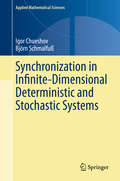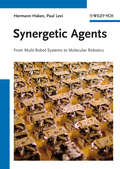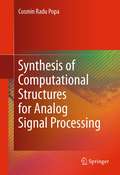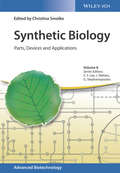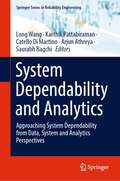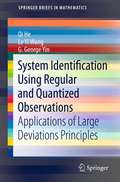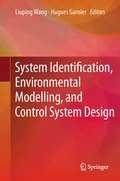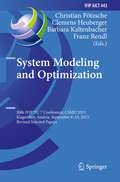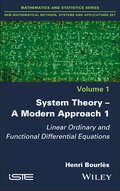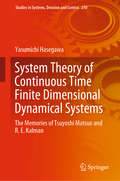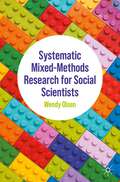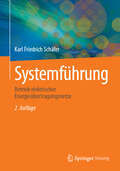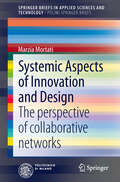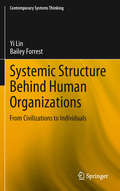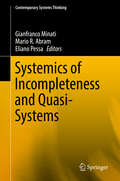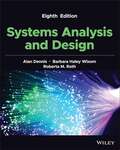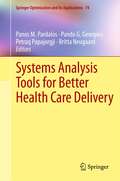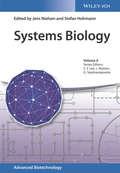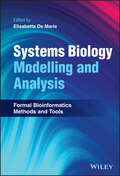- Table View
- List View
Synchronization in Infinite-Dimensional Deterministic and Stochastic Systems (Applied Mathematical Sciences #204)
by Igor Chueshov Björn SchmalfußThe main goal of this book is to systematically address the mathematical methods that are applied in the study of synchronization of infinite-dimensional evolutionary dissipative or partially dissipative systems. It bases its unique monograph presentation on both general and abstract models and covers several important classes of coupled nonlinear deterministic and stochastic PDEs which generate infinite-dimensional dissipative systems. This text, which adapts readily to advanced graduate coursework in dissipative dynamics, requires some background knowledge in evolutionary equations and introductory functional analysis as well as a basic understanding of PDEs and the theory of random processes. Suitable for researchers in synchronization theory, the book is also relevant to physicists and engineers interested in both the mathematical background and the methods for the asymptotic analysis of coupled infinite-dimensional dissipative systems that arise in continuum mechanics.
Synchronization in Networks of Nonlinear Circuits: Essential Topics With Matlab® Code (SpringerBriefs in Applied Sciences and Technology)
by Luigi Fortuna Arturo Buscarino Mattia Frasca Lucia Valentina GambuzzaThis book addresses synchronization in networks of coupled systems. It illustrates the main aspects of the phenomenon through concise theoretical results and code, allowing readers to reproduce them and encouraging readers to pursue their own experimentation. The book begins by introducing the mathematical representation of nonlinear circuits and the code for their simulation. This is followed by a brief account of the concept of the complex network, which describes the main aspects of complex networks and the main model types, with a particular focus on the code used to study and reproduce the models. The focus then shifts to the process through which independent nonlinear circuits that follow different trajectories without coupling share some properties of their motion: synchronization. The authors present the main techniques for studying synchronization in complex networks, including the major measures, the stability properties and control techniques. The book then moves on to advanced topics in synchronization of complex networks by examining forms of synchronization in which not all the units share the same trajectory, namely chimera states, clustering synchronization, and relay and remote synchronization. Simple codes for experimentation with these topics and control methods are also provided. In closing, the book addresses the problem of synchronization in time-varying networks.
Synergetic Agents: From Multi-Robot Systems to Molecular Robotics
by Paul Levi Hermann HakenThis book addresses both multi robot systems and miniaturization to the nanoscale from a unifying point of view, but without leaving aside typical particularities of either. The unifying aspect is based on the concept of information minimization whose precise formulation is the Haken-Levi-principle. The authors introduce basic concepts of multi-component self-organizing systems such as order parameters (well known from equilibrium and non-equilibrium phase transitions) and the slaving principle (which establishes a link to dynamical systems). Among explicit examples is the docking manoeuvre of two robots in two and three dimensions. The second part of the book deals with the rather recently arising field of molecular robotics. It is particularly here where nature has become a highly influential teacher for the construction of robots. In living biological cells astounding phenomena occur: there are molecules (proteins) that literally walk on polymer strands and transport loads that are heavier than their carriers, or molecules that, by joint action, contract muscles. The book provides the reader with an insight into these phenomena, especially by a detailed theoretical treatment of the molecular mechanism of muscle contraction. At the molecular level, for an appropriate approach the use of quantum theory is indispensable. The authors introduce and use it in a form that avoids all the clumsy calculations of wave-functions. They present a model which is based on an elementary version of quantum field theory and allows taking into account the impact of the surrounding on the quantum mechanical activity of a single molecule. By presenting explicit and pedagogical examples, the reader gets acquainted with the appropriate modelling of the walking behaviour of single molecular robots and their collective behaviour. The further development of multi-robot systems and particularly of molecular robots will require the cooperation of a variety of disciplines. Therefore the book appeals to a wide audience including researchers, instructors, and advanced graduate students.
Synthesis of Computational Structures for Analog Signal Processing
by Cosmin Radu PopaSynthesis of Computational Structures for Analog Signal Processing focuses on analysis and design of analog signal processing circuits. The author presents a multitude of design techniques for improving the performances of analog signal processing circuits, and proposes specific implementation strategies that can be used in CMOS technology. The author's discussion proceeds from the perspective of signal processing as it relates to analog. Included are coverage of low-power design, portable equipment, wireless nano-sensors and medical implantable devices. The material is especially appropriate for researchers and specialists in the area of analog and mixed-signal CMOS VLSI design, as well as postgraduate or Ph.D. students working on analog microelectronics.
Synthetic Aperture Radar (Springer Optimization and Its Applications #199)
by Panos M. Pardalos Arsenios Tsokas Maciej Rysz Kathleen M. Dipple Kaitlin L. FairThis carefully curated volume presents an in-depth, state-of-the-art discussion on many applications of Synthetic Aperture Radar (SAR). Integrating interdisciplinary sciences, the book features novel ideas, quantitative methods, and research results, promising to advance computational practices and technologies within the academic and industrial communities. SAR applications employ diverse and often complex computational methods rooted in machine learning, estimation, statistical learning, inversion models, and empirical models. Current and emerging applications of SAR data for earth observation, object detection and recognition, change detection, navigation, and interference mitigation are highlighted. Cutting edge methods, with particular emphasis on machine learning, are included. Contemporary deep learning models in object detection and recognition in SAR imagery with corresponding feature extraction and training schemes are considered. State-of-the-art neural network architectures in SAR-aided navigation are compared and discussed further. Advanced empirical and machine learning models in retrieving land and ocean information — wind, wave, soil conditions, among others, are also included.
Synthetic Biology: Parts, Devices and Applications (Advanced Biotechnology)
by Jens Nielsen Gregory Stephanopoulos Sang Yup Lee Christina Smolkeneed new text The inaugural volume of this new reference work in biotechnology is the most comprehensive of its kind on the market, covering everything from DNA synthesis to RNA interference and biosensors. Edited by the renowned scientists Sven Panke of the Swiss Federal Institute of Technology and Christina Smolke from Stanford University.
Synthetic Differential Topology (London Mathematical Society Lecture Note Series #448)
by Marta Bunge Felipe Gago Ana María San LuisThis book formally introduces synthetic differential topology, a natural extension of the theory of synthetic differential geometry which captures classical concepts of differential geometry and topology by means of the rich categorical structure of a necessarily non-Boolean topos and of the systematic use of logical infinitesimal objects in it. Beginning with an introduction to those parts of topos theory and synthetic differential geometry necessary for the remainder, this clear and comprehensive text covers the general theory of synthetic differential topology and several applications of it to classical mathematics, including the calculus of variations, Mather's theorem, and Morse theory on the classification of singularities. The book represents the state of the art in synthetic differential topology and will be of interest to researchers in topos theory and to mathematicians interested in the categorical foundations of differential geometry and topology.
System Dependability and Analytics: Approaching System Dependability from Data, System and Analytics Perspectives (Springer Series in Reliability Engineering)
by Long Wang Karthik Pattabiraman Catello Di Martino Arjun Athreya Saurabh BagchiThis book comprises chapters authored by experts who are professors and researchers in internationally recognized universities and research institutions. The book presents the results of research and descriptions of real-world systems, services, and technologies. Reading this book, researchers, professional practitioners, and graduate students will gain a clear vision on the state of the art of the research and real-world practice on system dependability and analytics. The book is published in honor of Professor Ravishankar K. Iyer, the George and Ann Fisher Distinguished Professor in the Department of Electrical and Computer Engineering at the University of Illinois at Urbana-Champaign (UIUC), Urbana, Illinois. Professor Iyer is ACM Fellow, IEEE Fellow, AAAS Fellow, and served as Interim Vice Chancellor of UIUC for research during 2008–2011. The book contains chapters written by many of his former students.
System Identification Using Regular and Quantized Observations
by Le Yi Wang George G. Yin Qi HeThis brief presents characterizations of identification errors under a probabilistic framework when output sensors are binary, quantized, or regular. By considering both space complexity in terms of signal quantization and time complexity with respect to data window sizes, this study provides a new perspective to understand the fundamental relationship between probabilistic errors and resources, which may represent data sizes in computer usage, computational complexity in algorithms, sample sizes in statistical analysis and channel bandwidths in communications.
System Identification, Environmental Modelling, and Control System Design
by Hugues Garnier Liuping WangThis book is dedicated to Prof. Peter Young on his 70th birthday. Professor Young has been a pioneer in systems and control, and over the past 45 years he has influenced many developments in this field. This volume comprises a collection of contributions by leading experts in system identification, time-series analysis, environmetric modelling and control system design - modern research in topics that reflect important areas of interest in Professor Young's research career. Recent theoretical developments in and relevant applications of these areas are explored treating the various subjects broadly and in depth. The authoritative and up-to-date research presented here will be of interest to academic researcher in control and disciplines related to environmental research, particularly those to with water systems. The tutorial style in which many of the contributions are composed also makes the book suitable as a source of study material for graduate students in those areas.
System Modeling and Optimization
by Christian Pötzsche Clemens Heuberger Barbara Kaltenbacher Franz RendlThis book is a collection of thoroughly refereed papers presented at the 26th IFIP TC 7 Conference on System Modeling and Optimization, held in Klagenfurt, Austria, in September 2013. The 34 revised papers were carefully selected from numerous submissions. They cover the latest progress in a wide range of topics such as optimal control of ordinary and partial differential equations, modeling and simulation, inverse problems, nonlinear, discrete, and stochastic optimization as well as industrial applications.
System Theory -- A Modern Approach, Volume 1: Linear Ordinary and Functional Differential Equations
by Henri BourlèsThe theory of dynamic systems is addressed in this book in accordance with the "modern" approach, heir to algebraic analysis, which has been implemented since the last decade of the 20th century. After a reminder of the evolution of the representation of systems based on transfer functions or matrices, the duality of controllability and observability is revisited, and new results are produced concerning time-varying discrete-time systems. To complete and improve the existing analyses, the poles and zeros of linear systems and their interconnections are presented in a new way, as well as the problem of systems governed by functional differential equations (of retarded or neutral type) and their stabilization. This book also proposes known and original mathematical complements.
System Theory of Continuous Time Finite Dimensional Dynamical Systems: The Memories of Tsuyoshi Matsuo and R. E. Kalman (Studies in Systems, Decision and Control #250)
by Yasumichi HasegawaThis book discusses the realization and control problems of finite-dimensional dynamical systems which contain linear and nonlinear systems. The author focuses on algebraic methods for the discussion of control problems of linear and non-linear dynamical systems. The book contains detailed examples to showcase the effectiveness of the presented method. The target audience comprises primarily research experts in the field of control theory, but the book may also be beneficial for graduate students alike.
Systematic Mixed-Methods Research for Social Scientists
by Wendy OlsenThis textbook provides clear and accessible guidance on the importance and practical application of mixed-methods research. Professor Olsen presents a range of multiple mixed-methods techniques using quantified data. Critical realism underpins key arguments. She offers detailed examples based on wide experience with international applied social-science projects. The book shows readers how to join quantitative and qualitative data together. Detailed methods include: using multiple-level data; constructing new indices based on mixing survey responses and personal interviews; and using focus groups alongside a large survey. The book provides readers with linkages of data between different software packages. It explains the analysis stage in mixed-methods research, interprets complex causality, shows how to transform data, and helps with interpreting social structures, institutions, and discourses. Finally, the book covers some epistemological issues. These include the nature and value of data. The author discusses validity and techniques for ensuring relevant, innovative conclusions. The book also touches on action research as an overarching participatory method.This book is based on clear and explicit definitions, is accessible to students and researchers across disciplines, and shows the appeal of mixed-methods research to those trained in quantitative methods.
Systemführung: Betrieb elektrischer Energieübertragungsnetze
by Karl Friedrich SchäferIn diesem Buch werden die wesentlichen Aufgaben der Systemführung von elektrischen Übertragungsnetzen beschrieben. Dazu gehören die Netzführung, die Einhaltung der Systembilanz, die Gewährleistung der Systemsicherheit und die Koordinierung des Stromhandels. Das Buch gibt einen Überblick über den Aufbau und die Struktur von Übertragungsnetzen sowie über deren geschichtliche Entwicklung. Die Einbindung der nationalen Übertragungsnetze in die europäische Verbundsystemführung und in die Sicherheitszentren ist ebenfalls Bestandteil dieses Buches. Es werden der Aufbau und die Aufgaben von Schaltleitungen beschrieben. Die künftige Entwicklung im Bereich der Systemführung wird an den Beispielen neuer Visualisierungskonzepte und kurativem Engpassmanagement skizziert.
Systemic Aspects of Innovation and Design
by Marzia MortatiThe book provides a snapshot of a hot topic - the systemic nature of innovation and its relevance to design - with a trifold perspective: the academic level - the literature on innovation studies and design is often neglected and a clear connection between the two topics taken for granted; the research level - collaborative models are currently considered great opportunities for transforming consumption, production and distribution of goods, but a clear scholarly discourse is still forming; the political level - the European Commission and the OECD are devoting much effort to understanding and measuring the impact of design in innovation processes and firms and a clear contribution would greatly support this path. Thus the book provides an informed, historical and nuanced perspective to the relationship between design and innovation to contribute to all three levels and to propose a point of view that goes beyond aesthetics and meanings.
Systemic Structure Behind Human Organizations
by Bailey Forrest Yi LinSystemic Structure behind Human Organizations: From Civilizations to Individuals shows how the systemic yoyo model can be successfully employed to study human organizations at three different levels: civilizations, business enterprises, and individuals. This monograph tackles managerial problems from an holistic perspective such as how a business entity grows and dies and how a CEO can manipulate the choices of long- and short-term projects in order to gain more control over the board of directors. By creating a uniform language and logic of reasoning, the book provides examples and convincing results. Additionally the book shows how the same model, thinking logic, and methodology of the systems research can be equally applied to analyze problems and situations considered in natural sciences, social sciences, and humanity areas. Therefore it offers knowledge of a brand new tool to attack organizational problems. By concentrating on difficult, unsettled issues in these varying areas, this monograph thoroughly explains how some laws of nature can be established for the common study of natural and social sciences.
Systemic Yoyos: Some Impacts of the Second Dimension (Systems Evaluation, Prediction, and Decision-Making)
by Yi LinA Novel Method to Analyze Problems and Encourage Systemic ThinkingReal-Life Case Studies Illustrate the Application of the Systemic Yoyo Model in Diverse AreasWritten by the co-creator of the systemic yoyo model, Systemic Yoyos: Some Impacts of the Second Dimension shows how the yoyo model and its methodology can be employed to study many unsettled
Systemics of Incompleteness and Quasi-Systems (Contemporary Systems Thinking)
by Gianfranco Minati Mario R. Abram Eliano PessaThis book contains the proceedings of the Seventh National Conference of the Italian Systems Society. The title, Systemics of Incompleteness and Quasi-Systems, aims to underline the need for Systemics and Systems Science to deal with the concepts of incompleteness and quasiness. Classical models of Systemics are intended to represent comprehensive aspects of phenomena and processes. They consider the phenomena in their temporal and spatial completeness. In these cases, possible incompleteness in the modelling is assumed to have a provisional or practical nature, which is still under study, and because there is no theoretical reason why the modelling cannot be complete. In principle, this is a matter of non-complex phenomena, to be considered using the concepts of the First Systemics. When dealing with emergence, there are phenomena which must be modelled by systems having multiple models, depending on the aspects being taken into consideration. Here, incompleteness in the modelling is intrinsic, theoretically relating changes in properties, structures, and status of system. Rather than consider the same system parametrically changing over time, we consider sequences of systems coherently. We consider contexts and processes for which modelling is incomplete, being related to only some properties, as well as those for which such modelling is theoretically incomplete—as in the case of processes of emergence and for approaches considered by the Second Systemics. In this regard, we consider here the generic concept of quasi explicating such incompleteness. The concept of quasi is used in various disciplines including quasi-crystals, quasi-particles, quasi-electric fields, and quasi-periodicity. In general, the concept of quasiness for systems concerns their continuous structural changes which are always meta-stable, waiting for events to collapse over other configurations and possible forms of stability; whose equivalence depends on the type of phenomenon under study. Interest in the concept of quasiness is not related to its meaning of rough approximation, but because it indicates an incompleteness which is structurally sufficient to accommodate processes of emergence and sustain coherence or generate new, equivalent or non-equivalent, levels. The conference was devoted to identifying, discussing and understanding possible interrelationships of theoretical disciplinary improvements, recognised as having prospective fundamental roles for a new Quasi-Systemics. The latter should be able to deal with problems related to complexity in more general and realistic ways, when a system is not always a system and not always the same system. In this context, the inter-disciplinarity should consist, for instance, of a constructionist, incomplete, non-ideological, multiple, contradiction-tolerant, Systemics, always in progress, and in its turn, emergent.
Systems Analysis And Design
by Alan Dennis Roberta M. Roth Barbara WixomSystems Analysis and Design, 8th Edition offers students a hands-on introduction to the core concepts of systems analysis and systems design. Following a project-based approach written to mimic real-world workflow, the text includes a multitude of cases and examples, in-depth explanations, and special features that highlight crucial concepts and emphasize the application of fundamental theory to real projects.
Systems Analysis Tools for Better Health Care Delivery
by Panos M. Pardalos Petraq Papajorgji Pando G. Georgiev Britta NeugaardThis book presents some recent systems engineering and mathematical tools for health care along with their real-world applications by health care practitioners and engineers. Advanced approaches, tools, and algorithms used in operating room scheduling and patient flow are covered. State-of-the-art results from applications of data mining, business process modeling, and simulation in healthcare, together with optimization methods, form the core of the volume. Systems Analysis Tools for Better Health Care Delivery illustrates the increased need of partnership between engineers and health care professionals. This book will benefit researchers and practitioners in health care delivery institutions, staff members and professionals of specialized hospital units, and lecturers and graduate students in engineering, applied mathematics, business administration and health care.
Systems Biology
by Jens Nielsen Gregory Stephanopoulos Sang Yup Lee J. Nielsen Stefan HohmannComprehensive coverage of the many different aspects of systems biology, resulting in an excellent overview of the experimental and computational approaches currently in use to study biological systems. Each chapter represents a valuable introduction to one specific branch of systems biology, while also including the current state of the art and pointers to future directions. Following different methods for the integrative analysis of omics data, the book goes on to describe techniques that allow for the direct quantification of carbon fluxes in large metabolic networks, including the use of 13C labelled substrates and genome-scale metabolic models. The latter is explained on the basis of the model organism Escherichia coli as well as the human metabolism. Subsequently, the authors deal with the application of such techniques to human health and cell factory engineering, with a focus on recent progress in building genome-scale models and regulatory networks. They highlight the importance of such information for specific biological processes, including the ageing of cells, the immune system and organogenesis. The book concludes with a summary of recent advances in genome editing, which have allowed for precise genetic modifications, even with the dynamic control of gene expression. This is part of the Advances Biotechnology series, covering all pertinent aspects of the field with each volume prepared by eminent scientists who are experts on the topic in question.
Systems Biology Modelling and Analysis: Formal Bioinformatics Methods and Tools
by Elisabetta De MariaSystems Biology Modelling and Analysis Describes important modelling and computational methods for systems biology research to enable practitioners to select and use the most suitable technique Systems Biology Modelling and Analysis provides an overview of state-of-the-art techniques and introduces related tools and practices to formalize models and automate reasoning for systems biology. The authors present and compare the main formal methods used in systems biology for modelling biological networks, including discussion of their advantages, drawbacks, and main applications. Each chapter includes an intuitive presentation of the specific formalism, a brief history of the formalism and of its applications in systems biology, a formal description of the formalism and its variants, at least one realistic case study, some applications of formal techniques to validate and make deep analysis of models encoded with the formalism, and a discussion on the kind of biological systems for which the formalism is suited, along with concrete ideas on its possible evolution. Edited by a highly qualified expert with significant experience in the field, some of the methods and techniques covered in Systems Biology Modelling and Analysis include: Petri nets, an important tool for studying different aspects of biological systems, ranging from simple signaling pathways to metabolic networks and beyond Pathway Logic, a formal, rule-based system and interactive viewer for developing executable models of cellular processes Boolean networks, a mathematical model which has been widely used for decades in the context of biological regulation networks Answer Set Programming (ASP), which has proven to be a strong logic programming paradigm to deal with the inherent complexity of biological models For systems biologists, biochemists, bioinformaticians, molecular biologists, pharmacologists, and computer scientists, Systems Biology Modelling and Analysis is a comprehensive all-in-one resource to understand and harness the field’s current models and techniques while also preparing for their potential developments in coming years with the help of the author’s expert insight.
Systems Biology of Metabolic and Signaling Networks
by Miguel A. Aon Valdur Saks Uwe SchlattnerSystems Biology represents a new paradigm aiming at a whole-organism-level understanding of biological phenomena, emphasizing interconnections and functional interrelationships rather than component parts. The study of network properties, and how they control and regulate behavior from the cellular to organism level, constitutes a main focus of Systems Biology. This book addresses from a novel perspective a major unsolved biological problem: understanding how a cell works and what goes wrong in pathology. The task undertaken by the authors is in equal parts conceptual and methodological, integrative and analytical, experimental and theoretical, qualitative and quantitative, didactic and comprehensive. Essentially, they unravel the spatio-temporal unfolding of interacting mass-energy and information networks at the cellular and organ levels, as well as its modulation through activation or repression by signaling networks to produce a certain phenotype or (patho)physiological response. Starting with the historical roots, in thirteen chapters this work explores the Systems Biology of signaling networks, cellular structures and fluxes, organ and microorganism functions. In doing so, it establishes the basis of a 21st century approach to biological complexity.
Systems Biology: Modeling, Analysis, and Simulation (Lecture Notes on Mathematical Modelling in the Life Sciences)
by Jinzhi LeiThis book discusses the mathematical simulation of biological systems, with a focus on the modeling of gene expression, gene regulatory networks and stem cell regeneration. The diffusion of morphogens is addressed by introducing various reaction-diffusion equations based on different hypotheses concerning the process of morphogen gradient formation. The robustness of steady-state gradients is also covered through boundary value problems. The introduction gives an overview of the relevant biological concepts (cells, DNA, organism development) and provides the requisite mathematical preliminaries on continuous dynamics and stochastic modeling. A basic understanding of calculus is assumed. The techniques described in this book encompass a wide range of mechanisms, from molecular behavior to population dynamics, and the inclusion of recent developments in the literature together with first-hand results make it an ideal reference for both new students and experienced researchers in the field of systems biology and applied mathematics.
